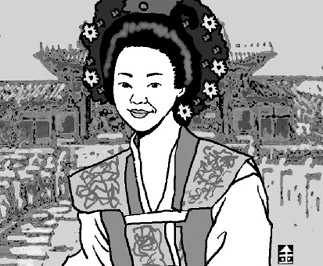Beautiful forgery transcends reality

Then in 1989, what was said to be a copy of the original kept in the Japanese Royal Library, suddenly appeared. The material included a biography of 32 pungwolju, or leaders of the code of Silla chivalry who lived from 540 to 681. This is when an intense debate started about whether the copy was a forged book or real history.
According to the copy, a heroine called Misil took center stage at the royal Silla court in the sixth century. She had three pungwolju husbands and lovers and ruled the court through the bedrooms of three kings, Jinheung, Jinji and Jinpyeong.
In other words, Misil’s life is the history of the Hwarang, a place where young people who excelled in beauty, bravery and military arts trained in the Silla Dynasty (57 B.C. ? A.D. 935).
However, we are not sure whether she actually existed because there are no traces of her in other documents.
The MBC TV drama “Queen Seondeok,” which has attracted legions of viewers, relies largely on this book.
The interesting point is the difference between Queen Seondeok in Samguk Sagi and Misil in Annals of the Hwarang. In the former, Queen Seondeok doesn’t have an easy road to the throne. Noblemen intensely opposed her because they could not accept a woman as the highest ruler.
Hostilities did not stop after she came to power. Emperor Taizong of Tang ridiculed a Silla ambassador, saying “If you do not have an appropriate leader, shall I send you a king?” Goguryeo and Baekjae, neighboring kingdoms, were offensive, too. Even the writer Kim Bu-sik added, “It is a great relief the country did not fall into ruin because it had a woman as ruler.”
On the other hand, Misil boasted beauty and grace, but even the ruling powers joined her side using dignity and political tactics. A sense of respect can be felt from the end of the pen as the writer records the effects Misil had on the Hwarang.
Is this difference in perspective a difference between Kim Dae-mun of the Silla Dynasty and Kim Busik of the Goryeo period, or evidence that Annals of the Hwarang is a forged book from a 20th-century perspective?
Whether or not the document is real is something for the academic world to decide, but the structure of Annals of the Hwarang is so thorough and magnificent that it would be even more impressive if it were revealed to be a creation, not reality. I wonder if Misil really did exist.
The writer is a team manager at JES Entertainment.
By Song Won-sup [five@joongang.co.kr]










with the Korea JoongAng Daily
To write comments, please log in to one of the accounts.
Standards Board Policy (0/250자)